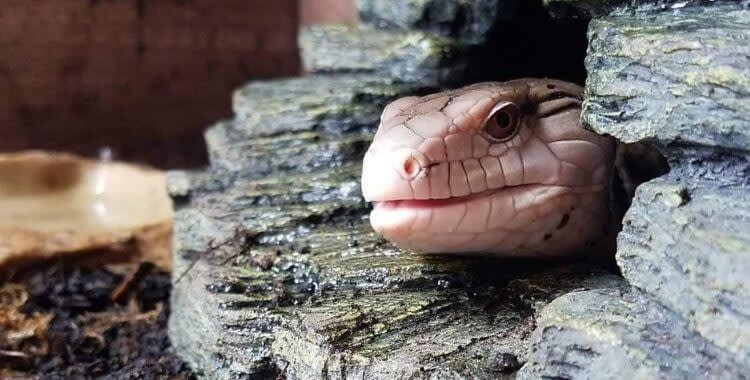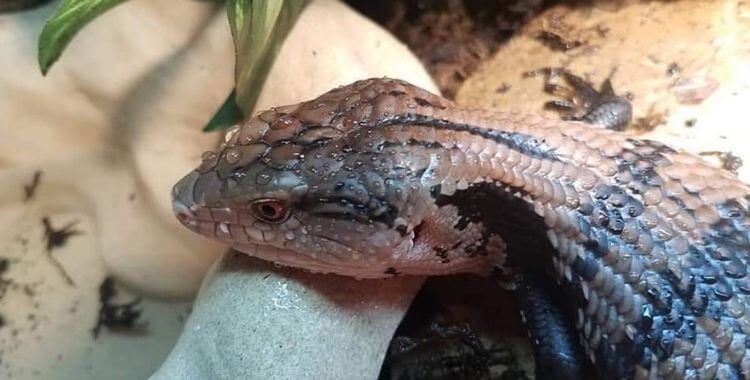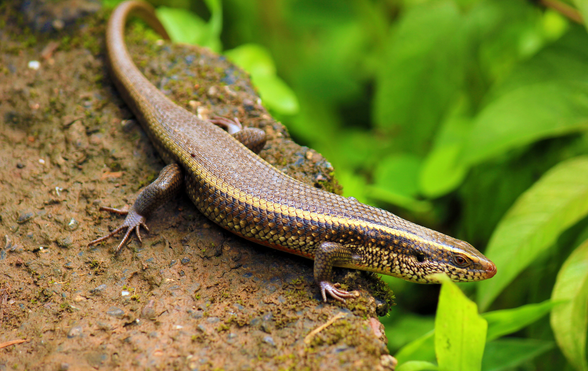Blue-tongued skinks (Tiliqua scincoides intermedia) are an opportunistic omnivorous species.
Don’t forget your lizard insurance! Get a quote for £1,000 of vet fees, death and theft cover. Vet fee cover only also available | We’ve been insuring exotic pets since 1996 | Check out our customer reviews on Feefo.
This means that they eat plant, vegetables, fruit, and insects in their wild environment. However, they do tend to prefer insects to plants.
In their natural habitat of Australia and Indonesia, they will consume a variety of insects, with snails, slugs, termites and grasshoppers in high consumption.
What insects can Blue-tongued skinks eat?
Your Blue-tongued skink can eat all available cricket species, calcium worms (Black Soldier Fly larvae) morios, locust, silkworms, dendrobaena (earth worms), varied roach species and snails.
Remember, within the captive diet it’s vital we replicate the need for dietary variety. So feeding as many insect feeder species as possible, along with greens, veg and dietary additions for nutritional variety.
With the options available to us via online ordering, this should be fairly easy to achieve.
 Thanks to Lexi for sharing her pictures of Henry, her Blue-Tongued skink with us
Thanks to Lexi for sharing her pictures of Henry, her Blue-Tongued skink with us
Jump to: What fruit can Blue-tongued skinks eat? | What vegetables can Blue-tongued skinks eat? | Toxic food | What greens can Blue-tongued skinks eat? | What else can they eat? | Dog and cat food | How often do I feed my Blue-tongued skink? | Not eating | What do they eat in the wild?
What fruit can Blue-tongued skinks eat?
Field research has shown fruit is a large part of a Blue-tongued skink’s natural diet. But it is mostly that of the berry variety.
Therefore keeping to the berry theme is ideal, with blueberries, blackberries, raspberries and strawberries being great options for this part of the diet.
Feeding a little banana, apple, pear or melon are all good treat options for that important variety and balance. However these should be kept to a minimum.
Do not feed any citrus, like lemon or orange, etc as citrus can cause stomach problems for reptiles.
What vegetables can Blue-tongued skinks eat?
You can feed your Blue-tongued skink butternut squash, acorn squash, summer squash, spaghetti squash and hubbard squash.
These all make great additions to your Blue-tongued skink’s diet, with them often being seasonal, apart from butternut squash which is available throughout the year.
Green beans, prickly pear (Optunia cactus pad) and mulberry leaf are also great for regular feeding too.
Items such as broccoli, brussel sprouts, bell-pepper, carrots, cauliflower, celery, cucumber, parsnips, sweet potato, spring greens, pumpkin and turnip are also good for occasional feeding, to help keep a picky vegetable dodger happy.
You’ll find that vegetable content is often the part of the food bowl that is dodged by many omnivore species, and the Blue-tongued skink is no different here.
To overcome its best to cut pieces up smaller than the rest of the food in the bowl, and hide in between the greens etc.
The vegetable content will provide a great part of the needed dietary variety, and items such as all the squash varieties are perfect for daily use alongside other content.
 Thanks to Lexi for sharing her pictures of Henry, her Blue-tongued skink with us
Thanks to Lexi for sharing her pictures of Henry, her Blue-tongued skink with us
Toxic food for Blue-tongued skinks
Items such as avocado, onion, eggplant, rhubarb, buttercups, potatoes and tulips are all considered toxic, therefore should be avoided at all costs.
What greens can Blue-tongued skinks eat?
It’s well worth considering growing your own weeds and flowers to add to your Blue-tongued skinks diet. Or, while out walking the dog, pick some of your own, away from roads and water sources.
You can pick items such as dandelion greens, hibiscus, gloxinia, rose, bramble leaf, dead nettle, plantain, mallow, hawkbit, hawks-beard and sticky weed.
These examples are readily available throughout the spring, summer and autumn in the UK.
Also, if unsure in what you are picking, use the PlantNet app available on android and iPhone, along with the amazing resource of the TortoiseTable app, available on android, iPhone, and website.
And yes, what’s safe for a tortoise to eat regarding vegetation – leaves and flowers, is 100% safe for your Blue-tongued skink.
What else can Blue-tongued skinks eat?
Based on their natural diet, which involves a lot of scavenging, they would seek the raw animal parts of a corpse such as the heart, liver and kidney. So, feeding such within the diet is a good idea.
Chicken and turkey: Cooked chicken heart, chicken liver, turkey heart and/or liver can be eaten, and are very nutritious. However, they should be considered a treat only, once every couple of weeks is enough.
Chicken or quail eggs: These can be given raw, but boiled or scrambled is better and far less messy for the keeper. Raw egg gets very sticky.
Fish: This should be free of bone, and only be given in small bite-sized pieces.
Any actual meats such chicken, turkey, duck or beef should always be cooked, never raw, as this poses far too much of a contamination and poisoning risk.
Actual meats should be viewed as a treat only, as your skink’s main meat/protein source should be insect based.
Is dog or cat food okay for Blue-tongued skinks?
Many Blue-tongued skink keepers use dog and cat foods and swear on their benefits.
When I had Blue-tongued skinks I never found it necessary to use dog food too much. In fact I’d only use it once a week, or once every two weeks.
If you do insist on using it as part of a varied diet, use only high quality zero grain low carbohydrate brands – as skinks struggle to digest grain and carbohydrates. This is why potatoes are not good for them.
When comparing between dog and cat foods – dog foods are far more ‘in-line’ with their natural diet as they contain added vegetables, etc.
Cat foods don’t contain added vegetables, as cats are 100% carnivorous. So it’s better to stick to a top quality dog food if one is to be used.
However, a far better alternative to either of these are the dietary addition products such as Arcadia Omnigold, Insectigold, and Respashy’s Bluey Buffet.
These are powder based products where you add water and mix till it’s very much like a dog or cat food consistency.
The ingredients vary depending on the products, but most have an insect and animal protein base, with added egg, flowers, herbs, plants, and essential vitamin and minerals.
The mentioned Arcadia products work best for me, and they also benefit many other insect eating species, like Bearded Dragons for example.
How often do I feed my Blue-tongued skink?
When it comes to how often to feed, and how much, this would vary depending on age as it does for all reptiles.
0-6 months old: Feed daily with insects for only a minute or two, and a small portion of greens. Don’t overdo the greens though.
6-12 months: If deemed healthy by a herp vet, your Blue-tongued skink can now be fed with insects, greens and vegetables but every other day.
12 months +: Again, if deemed healthy, feeding three times a week is plenty following the insect, greens and vegetable diet.
For the dietary addition products: I use these instead of insects once a week only. This works for me and gives the skink something different in smell and taste, as well as texture to keep them interested.
My Blue-tongued skink is not eating
Vivarium temperatures: More often than not, a Blue-tongued skink refusing to eat is due to an issue within its provided enclosure.
It’s always worth double checking the temperatures in the basking zone are as they should be. You should check with a digital probe thermometer, not a stick on dial.
UVB: Check the UVB is in date, and at the correct distance. These tubes need replacing anywhere between 4-6 months for some brands. But brands such as Arcadia and ZooMed, you are good for 12 months.
Illness: More often than not, the issue would be a parasite burden. Reptiles get internal parasites, although those such as pinworms are not considered harmful in low numbers.
A healthy reptile will keep them under control without issues, but illness and stress can happen and the parasites can multiply causing issues. This can cause upset within its body as it would for any species.
You can check whether this is the case via a faecal test from your vet.
Depending on the results, medication could be provided. After the meds are complete, and another faecal re-test, all should be good.
It’s worth noting that Blue-tongued skinks often go off food when taking medication, as well as after the medication is complete. Although this is usually for a short period.
Therefore if otherwise healthy, and the count of eggs is low, it can often cause more issues to treat parasites. So many vets would choose not to if that’s the case.
Don’t be tempted to not see the vet. The decision whether to treat, should always be made by them. The health of your reptile comes first.
If meds are prescribed, talk to your vet regarding the use of a probiotic to aid the gut-flora in restoring its balance, thus stimulating hunger again.
Skin shedding: Other common issues that can cause the Blue-tongued skink to refuse food would be shedding its skin.
They often wait until they are done shedding before wanting to eat. If your Blue-tongued skink is healthy, this won’t be a problem at all.
Brumation: like many other cold-blooded species, brumation is a naturally triggered time during the colder months where a reptile will hide itself in a burrow.
This is a time where its natural food in the wild would be less available. They would live off their body’s stored nutritional reserves, and wake in the warmer spring when their natural food sources are much more abundant.
This does happen within the captive environment, so you should check with your exotic vet and proceed with their recommendation.
What do Blue-Tongued skinks eat in the wild?
What is eaten will depend on the species of Blue-tongued skink, which would also mean we have to take into account the local region and regional foods available.
With that being said, all will consume insects – with grasshoppers, beetles, snails, woodlice, worms, other larvae, and even ants being high on the menu due to their widespread availability.
They will even scavenge and consume meat from dead animals, as well as cattle dung.
When it comes to plant matter, as mentioned at the start, research has found they will consume many berries and seed on native bushes, as well as leaves and seasonal flowers and weeds such as hibiscus, rose and dandelion.
So, their natural diet is not always the healthiest, but they eat based on survival.
A captive diet should be varied, and with this variety you’ll have a far healthier skink than that of its wild cousins. This in-turn will give you a longer living far healthier reptile.
Photo credits: Many thanks to Lexi for providing us with the pictures of Henry, her Blue-Tongued skink, for this article.
Don’t forget your lizard insurance! Get a quote for £1,000 of vet fees, death and theft cover. Vet fee cover only also available | We’ve been insuring exotic pets since 1996 | Check out our customer reviews on Feefo.

